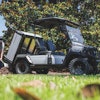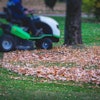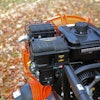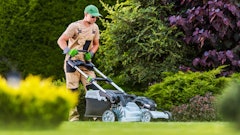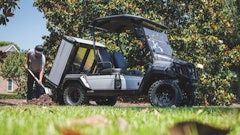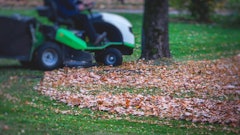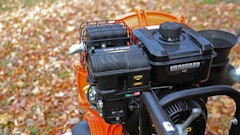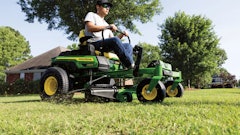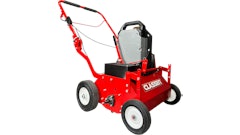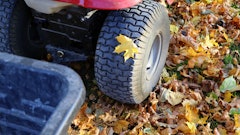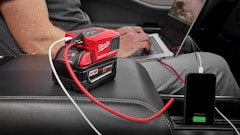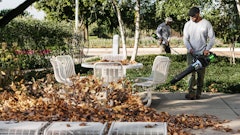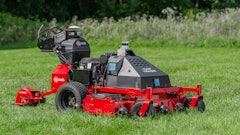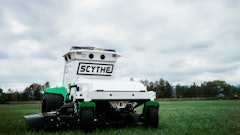
It's important that batteries are stored in a dry, dust-free location, out of the reach of children.
Husqvarna
As battery-powered equipment becomes more popular, landscape pros need to understand how to winterize the equipment. Follow the checklists below to ensure your battery-powered equipment remains in top condition come spring.
Before storage
- Inspect the battery for any damage such as cracks in the housings, corrosion on the terminals and scuffs.
- Exercise care in handling batteries to avoid shorting the battery with conducting materials such as rings, bracelets, keys, paper clips, coins, keys, nails, screws or other small metal objects that can make a connection from one terminal to another.
- Consider taking handheld battery tools for a checkup at a local dealer to ensure everything is functioning correctly, including necessary updates and component replacements. Ensure service is performed by a qualified repair person using only identical replacement parts.
- On equipment such as mowers, check the cutting deck, blades and belts for any signs of wear and tear.
- Remove dirt, dust, grass clippings and other debris that build up during the busy months. Most battery-powered equipment can be cleaned by scrubbing with a soft-bristle brush and water or mild detergent. Be sure to pay attention to hard-to-reach areas where organic matter may accumulate. After cleaning, dry your tools completely to prevent rust and decay.
- Check for moisture in the motor and listen for odd noises that could signal damage.
- Inspect and tighten all the screws and nuts.
- Cover the battery compartment of the power head.
- Protect the charger from getting wet from rain and snow. Be aware that some battery-powered equipment may be equipped with temperature sensors that prevent operation if temperatures are below zero degrees F.
Storage tips
- Remove the battery from the charger and disconnect the battery charger from the power supply.
- Store the batteries in a dry, dust-free location, out of the reach of children. Store the battery in a temperature range of 41 degrees F to 77 degrees F to avoid extreme conditions that can impair performance. Steer clear of attics or unheated garages where temperatures can fluctuate dramatically and instead consider bringing them indoors. An enclosed space protects equipment from rain, snow and sleet and provides some protection against freezing. Covering with a drop cloth or a tarp is also advised to prevent dust and dirt buildup in electronic components.
- Ensure the battery is charged to around half capacity, ideally between 40% to 50%, as this maximizes its lifespan. Most power tool batteries likely include a button to check the battery status. If storing the battery for longer than three months, the battery should be fully charged before storage. Storing a battery for long periods of time with a less than 40% charge can prevent the battery from being able to recharge when coming out of storage. Batteries should be charged from 60% to 100% before storing for extended periods of time, ensuring the battery will be ready to go for the spring season.
- Keep equipment separated from fertilizer or other corrosive materials that may be stored in the same space.
After storage
- Charge any batteries that have been stored.
- Inspect batteries for corrosion.
- Clean surfaces that may have gathered dust or moisture.
- Consider taking larger equipment to a service center for a thorough checkup, especially if not done over the previous fall or winter. This is particularly important to ensure intricate mechanical parts are in top shape.
Avoid challenges
If not stored properly, landscapers may experience the following consequences with their battery-powered equipment.
- Battery degradation: Storing batteries in cold or fluctuating temperatures without proper care can lead to capacity loss, reduced run time or total failure. Batteries should be kept in a cool, dry place and ideally at around 50% charge to preserve longevity.
- Battery contacts or chargers malfunctioning: Improper storage of chargers and batteries, particularly in freezing or damp environments, can cause contact points to oxidize, creating poor connections and affecting recharging ability.
- Motor damage: If moisture accumulates in the equipment during winter storage and freezes, it can damage sensitive electronic components like the motor, leading to malfunctions when restarted in the spring.
- Corrosion: Any leftover moisture or debris in the equipment could lead to corrosion, particularly around electrical contacts, switches or battery terminals, affecting power transfer or even rendering the equipment unusable.
Sources: Jason Wilk, senior product manager for Echo; Chris Richert, product manager, handheld battery for Husqvarna; George Reister, director, residential product from Husqvarna; and Clint Briscoe, senior product manager at The Toro Co.


